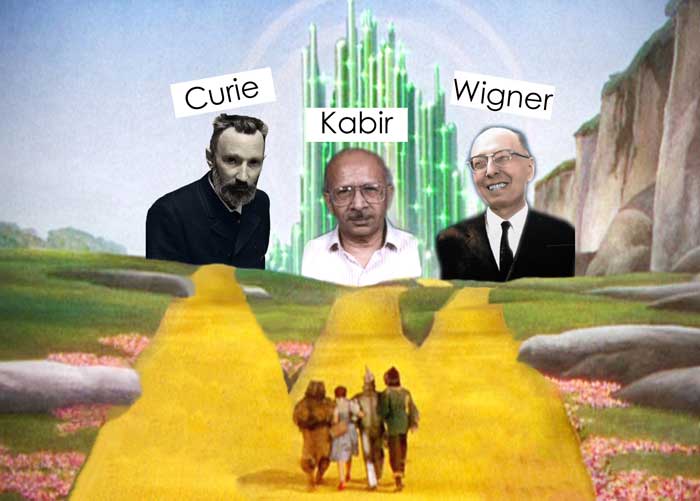Three merry roads to T-violation
Last year I had a back-and-forth Abhay Ashtekar. It was during a lively conference organised by Emily Grosholz and hosted by the Center for Gravitaiton and the Cosmos where Ashtekar is director. Our discussion was about the arguments underpinning the evidence for time asymmetry in fundamental physics.
Our discussion has finally come out in a special issue of Studies in History and Philosophy of Modern Physics:
- Roberts (2014) Three merry roads to T-violation (philsci-archive)
- Ashtekar (2014) Response to Bryan Roberts: A new perspective on T violation (arxiv)
- Roberts (2014) Comment on Ashtekar: Generalization of Wigner׳s principle (arxiv)
Here’s a cheerful little essay on what our discussion was about.
Asymmetries in time
We all experience asymmetry in time. We’re not getting any younger. We smash glasses, but don’t un-smash them. We notice cigarette smoke dissipating but never compressing back into the cigarette.
However, those time asymmetries only appear in systems arranged with special initial conditions. They occur when a system begins in a “highly organised” low entropy state, and therefore must evolve into a “disorganised” high entropy state by the second law of thermodynamics. These asymmetries do not occur when a system begins in an equilibrium state, where all the familiar time asymmetries tend to disappear.
However, in the mid-20th century, a radical new kind of time asymmetry was discovered. This new time asymmetry did not depend on initial conditions. It was built right into the laws of physics themselves. And it came as an incredible surprise to physicists when it was first discovered by Cronin and Fitch in 1964. Leading theories were overturned. Nobel prizes were awarded. The phenomenon was recorded in the textbooks, and came to be referred to as T-violation.
The curious case of T-violation
But here is something curious about this episode: at the time, we didn’t actually know what the laws of physics were. Somehow managed to determine that the laws of physics are T-violating without actually knowing the precise laws of physics.
In particular, in 1964 there was no standard model. We did not understand the Hamiltonian or Lagrangian for these systems, which is what determines the precise form of the laws governing their motion. And yet, through some beautifully clever reasoning, experimentalists managed to show that the laws are T-violating.
So, what kinds of arguments made this possible? And how robust were those arguments? There were basically three kinds of answers.
Three merry roads to T-violation
In “Three merry roads to T-violation“, I argued that if you draw out the basic skeletal arguments, you see that there are three roads to T-violation currently being explored. Each makes use of a symmetry principle in order to establish that the laws of physics are T-violating. And each works even when we don’t have a very clear picture of the laws themselves.
- T-violation by Curie’s principle. Pierre Curie declared that there is never an asymmetric effect without an asymmetric cause. This idea, together with the CPT theorem, provided the road to the very first detection of T-violation in the 20th century. (It is also itself the subject of some recent debate in philosophy of physics, e.g. here, here and here.)
- T-violation by Kabir’s principle. Pasha Kabir pointed that, whenever the probability of an ordinary particle decay A → B differs from that of the time-reversed decay B′ → A′, then we have T-violation. This second road provides a very direct test for T-violation, which was successfully carried out by the CPLEAR experiment at CERN in 1998.
- T-violation by Wigner’s principle. If certain kinds of exotic matter turn out to exist, such as an elementary electric dipole, then this would lead immediately to T-violation. This provides the final road, although it has not yet led to a successful detection of T-violation.
But how robust are these principles? The standard model of particle physics will certainly be adjusted as physics continues to progress. Will the arguments for T-violation be lost when we proceed beyond the standard model? Or, are they robust enough to stay with us even as our theories change?
Generalisation in general mechanics
Ashtekar pointed out in his response that in fact Curie’s principle and Kabir’s principle are both surprisingly robust.
His approach introduced a helpful tool that he calls general mechanics. It is a framework that allows one to peel back much of the special structure of quantum theory that distinguishes it from other theories, and focus on a few core structures that are shared by many other theories as well. This includes many alternatives to the standard model.
What Ashtekar showed was that the first two roads to T-violation, Curie’s Principle and Kabir’s Principle, are valid even in the stripped-down framework of general mechanics. These principles rely on very little of the basic structures that characterise quantum theory:
- Unitary evolution (or “Schrödinger” evolution) is not presumed.
- The superposition principle is not presumed (nor is any linear structure)
- The notion of an observable is not presumed.
And yet the core arguments that our world is T-violating are still correct.
What about the Wigner’s Principle approach? In my short comment on Ashtekar written after the conference, I showed that the it too is valid in general mechanics.


